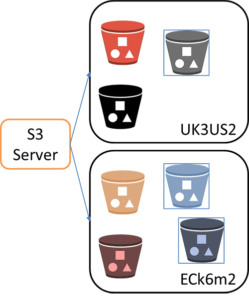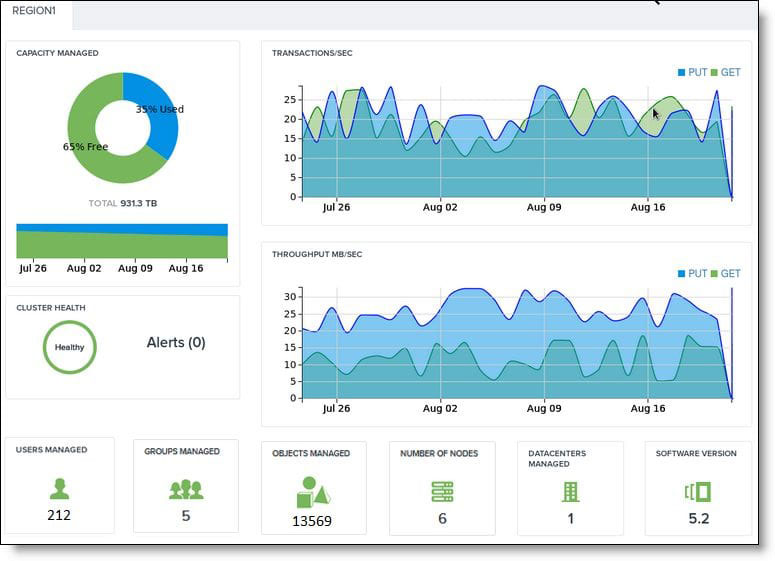Amazon’s S3 API is the de-facto standard for object storage APIs. Having multiple service providers, software providers, and applications standardize on S3 has made it easier to interchange between them and rapidly stand up new uses for object storage. But there are different grades of S3 compatibility. Some software and solutions provide only the basic CRUD (create, remove, update, delete) functions. At the other end is Cloudian’s Hyperstore, committed to providing the highest fidelity S3 compatibility backed by a guarantee.
The S3 API is an HTTP/S REST API where all operations are via HTTP PUT, POST, GET, DELETE, and HEAD requests. Each object is stored in a bucket. Beyond the basic object CRUD operations provided by S3, there are many advanced APIs like versioning, multi-part upload, access control list, and location constraint. There are multiple options for encryption including (1) server-side encryption where the server manages encyrption keys, (2) server-side encyption with customer keys, and (3) client-side encryption where the data is encrypted/decrypted at the client side. Though no single S3 user is likely to use all of the advanced APIs, the union of APIs used by different users quickly covers them all. The table below highlights some advanced object storage APIs supported by S3:
| S3 Feature | Azure | Google Cloud | OpenStack Swift |
| Object versioning | No | Yes | Yes |
| Object ACL | No | Yes | No |
| Bucket Lifecycle Expiry | No | Yes | Yes |
| Multi-object delete | No | Yes | Yes |
| Server-side encryption | No | Yes | Yes |
| Server-side encryption with customer keys | No | No | No |
| Cross-region replication | Yes | No | Yes |
| Website | No | No | No |
| Bucket logging | No | No | No |
| POST object | No | No | No |
Table 1 – Comparison of some S3 advanced object storage APIs[1]
S3 API compatibility is a prerequisite, but not sufficient to provide object storage for enterprises. There are 4 additional areas that Cloudian has added to make S3 object storage enterprise-ready.
- Software or Appliance, not a service.The software-only package includes a Puppet-based installer with a wizard-style interface. It runs on commodity software (CentOS/RedHat) and commodity hardware. The appliances come in a few fixed models ranging from 1U (24TB) to the FL3000 series of PB-scale in 8U form.
- APIs for all functions
- Configuration
- Multi-Tenancy: User/Tenant provisioning
- Quality of Service (QoS)
- Reporting
- S3 Extensions: Compression, Metadata APIs, Per-bucket Protection Policies.
Highlighting the per-bucket protection policies feature, each bucket can have its own protection policy. For example, a“UK3US2” policy can be defined as UK DC with 3 replicas and US DC with 2 replicas. Another example is a “ECk6m2” policy as DC1 with Erasure Coding with 6 data and 2 coding fragments. As buckets are created they can be assigned a policy.

Figure 1 – Per-bucket protection policies example
- O&M tools to install, monitor, and manage.In addition to the installer, a single pane web-based Cloudian Management Console (CMC) does system administration from the perspective of the system operator, a tenant/group administrator, and a regular user. It’s used to provision groups and users, view reports, manage the cluster, and monitor the cluster.

Figure 2 – CMC dashboard
- Integration with Other Products
- NFS/CIFS file interface
- OpenStack, CloudPlatform
- Tiering to any S3 system (public or private).
- Active Directory, LDAP
The opportunity and use case for enterprises and object storage has never been more compelling. Amazon S3 API compatibility ensures full portability of already working applications. Using Cloudian’s HyperStore platform instead of AWS, enterprise data can be brought on-premise for better data security and manageability at lower cost. For STaaS providers, S3 API compatibility, backed by a full guarantee, provides the same benefits of a fully controlled storage platform, and opens up a large range of compatible applications. Beyond the S3 API, Cloudian is committed to providing all operations by API and has added APIs to make the platform enterprise-ready, including multi-tenancy.
If you would like a technical overview, you can check out this webinar I recently presented, “S3 Technical Deep Dive” and make sure to check out more information on our S3 Guarantee…we’ll run all your S3 Apps anytime and anywhere – Guaranteed!
– Gary
—
[1] References:
http://docs.openstack.org/developer/swift/#object-storage-v1-rest-api-documentation
https://cloud.google.com/storage/docs/xml-api-overview
https://msdn.microsoft.com/en-us/library/azure/dd135733.aspx


